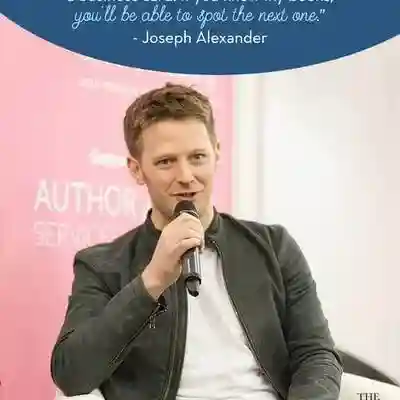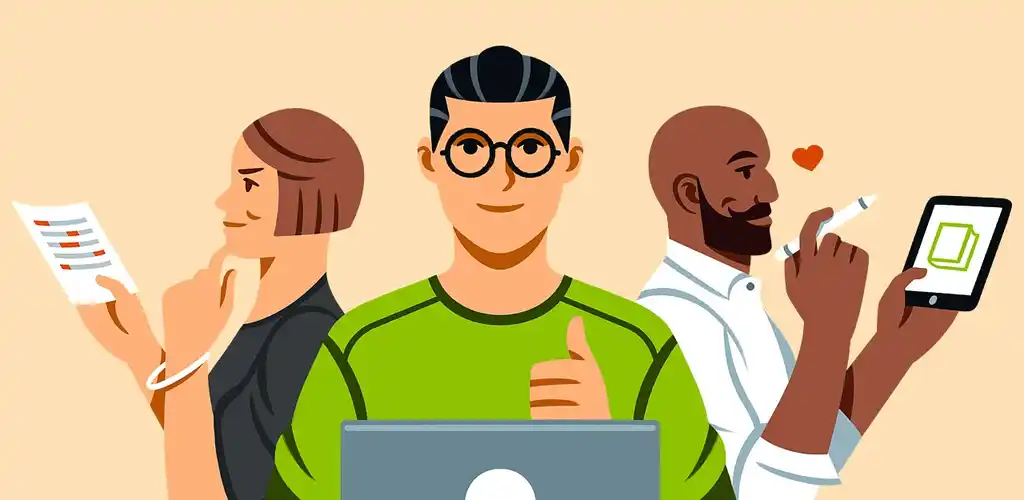Winning Amazon's Secret Popularity Contest (with David Gaughran)
20:00 EST - Jan 24, 2018
Hello and welcome to Amazon's Secret Popularity Contest, which is a click bait-y title if ever there was one and I hope it's going to live up to us. I'm an Irish author, which you might have guessed by the accent and you might have guessed I'm a full-time author by the huge beard on my face. I was actually supposed to shave but I've been writing three books back to back so that kind of thing has fallen by the wayside. Hopefully, I'll get rid of it before the summer when things heat up a little.
I write historical fiction mainly. That's my main job. And I also write quite a bit of nonfiction, books for writers primarily. I've written one on how to self-publish and I've written another one, Amazon Decoded, which is kind of related to the talk today. It breaks down how all the algorithms work on Amazon and how you should change your marketing to take advantage of that because I think we all know, especially the people that have been around for a few years that marketing is getting much more complicated. Sometimes that means much more expensive but there are actually a lot of cool free things that you can do to increase your visibility on Amazon, which is as everyone knows the biggest bookstore in the world.
Part 1: Amazon’s recommendation engine
I know Amazon's a very hot-button topic. People love Amazon or hate Amazon. They always have an opinion. I have a blog where I talk about all sorts of things and any post about Amazon will always get 10 times as much traffic: both from the haters and the lovers. I don't really care about all of that. I care about using Amazon to reach readers and sell as many books as possible. I spend a lot of time trying to figure it out.
Google vs Yahoo!
I feel that you need to understand why Amazon's approach to bookselling is very different and if you don't mind going into a tiny little bit of a tech world history lesson just for about 30 seconds, I used to work for Google and I joined Google at the time they were having a big fight with Yahoo. Yahoo was actually the big dog in search at the time. Google's approach to search was very very different. Yahoo was selling off the top bar above the search, the prime real estate. They were selling that off to the highest bidder and whoever paid the most money got to appear there.
Google took a radically different approach. They decided that relevancy was going to be just as important as how much money someone was willing to spend, which meant they picked their rate basically. If you put a bad ad up there and a lot of people didn't click on it, Google would make it disappear. What that meant over time was that the ads became more relevant and that people trusted the ads more and they clicked on them more. That's why Google won. Amazon would have known all about that. They would have watched that battle. They would have seen the importance of building of trust with your customers and making sure that the recommendations you give them are relevant.
How Amazon changed the bookselling trade
Amazon's core philosophy is that they always want to show you the products that you're most likely to purchase. And where that's important for us in the world of books is they're only going to recommend books to you if they think you actually want to buy them and read them. And as funny as this sounds this was actually a revolutionary approach in the world of bookselling.
If you go into your local Barnes and Noble (or your Waterstones if you're in the UK, or your Eason's if you're in Ireland), you'll notice there's a front table as you walk in the door. And there'll be all these books piled high up there. They're usually the familiar names. The same ones you see at the airport bookstore, which will often only be stocking those books: people like John Grisham and James Patterson and Nora Roberts. All those huge traditionally published authors. Those same kinds of authors will be positioned beside the cash register as you're paying for your books and on other high visibility spots around the bookstore. I think a lot of us as readers assumed that the store manager decided which books appeared there, but it’s not: that's actually real estate and those spots are bought and sold.
The contract between the publisher and the bookseller will literally say whether a book is face-edge or spine-edge on the shelf. And generally, they're only going to do that for their biggest authors where they've paid the six-figure advance that they need to recoup. They're generally not going to do that for an author who they've only picked up for about five grand.
That's the traditional way that high visibility spots are doled out in the traditional publishing business. If you look at retailers like Kobo and Barnes & Noble, that's kind of how they do it online as well, more or less.
Amazon is very different. They don't sell off those spots. Anybody can appear on the front table on Amazon. You or me or anybody else. Amazon will always show you the book the assistant thinks you are most likely to purchase. And it doesn't care whether Penguin has published that book or whether I published it. It doesn't care whether the book is $14.99 or even 99 cents or free. It will always attempt to show the book that it thinks you're most likely to purchase.
And as writers, we actually don't get to see the full recommendation system because we tend to stalk a lot of books that we wouldn't normally read — books outside of our genre. I'm always looking at what everybody else is doing and trying to figure out how they got into the charts and seeing if there's anything I can learn for myself. That throws off Amazon's system and sometimes I get recommended a lot of books I wouldn't read. I think it's the same for a lot of people that work in publishing or who are writers.
If you talk to readers, especially ones who use Amazon a lot, they will often say that the recommendations they get are eerily accurate. A lot of the book purchases they make every week or every month will be driven by those recommendations. For us as writers, trying to reach as many readers as possible, it's extremely important to understand how this recommendation engine works. And if you know how it works then you can turn that to your advantage.
Sales Rank
Every book has a rank on Amazon which will tell you how it's selling in relative terms to other books and if you're number one in the rankings that means you're the best selling book this hour basically and if you're number one million that means there are nine hundred and ninety-nine thousand, nine hundred and ninety-nine books selling more than you at this current moment. There's a lot of churn in it. It changes every hour and basically a sale today will be worth very little tomorrow and almost nothing in a couple of days. It really does change around a lot.
When, so function first started out — I think in 2009 or 2010, just before it went mainstream — people figured out how it worked and very quickly started doing something called a “book bomb,” which was they would organise all their friends to buy their book at 11:00 a.m. on a Tuesday morning. They wanted to see if that would throw the book right up the charts because the system updates every hour and it also looks at how quickly your book is selling over the day and things like that. It worked. These books jumped up in the charts. And Amazon obviously didn't like that because it was a very easy way for people to game the system.
Avoiding sales spikes
As it is right now, if Amazon sees a one-off spike where a book has jumped out of nowhere into the charts very quickly and there's nothing coming after it in terms of organic sales activity it will actually push your book down almost as quickly.
What that means for us today is that we have to be aware of that when we're organizing our promotions. If you have a mailing list and a few blog subscribers and a few people following you on Twitter the temptation sometimes when we launch a book is to hit all that at once and see how high it can go and that's a mistake. What we really need to do is spread all of that juice over four or five days so the system doesn't think that this is an artificial book bomb or spike with nothing behind it. And the system will treat your book more kindly and if you do it right it'll actually start recommending your book to lots and lots of Amazon customers.
Getting Amazon to sell your book for you
That's the idea. That's what we're always aiming for. Because I'm in the middle of launching a book at the moment and I'm doing a pre-order for the first time, which means instead of pushing my book for four or five days, I've been pushing it for 10 days or two weeks and even now, I'm running out of juice. There's only so much juice anyone has.
What you're always hoping with a promotion like that is that Amazon system will take over at some point. I remember when the best launches I had back in 2014, I only did four or five days of a good push and then Amazon system took over. And it sold that book for me at almost the same level for another six to eight weeks and I was doing nothing. I wasn't spending any money on advertising, I wasn't going around telling people to buy it, I wasn't doing anything. Amazon was selling it for me and that's always the goal.
That kind of approach, understand the Amazon system and how it works, you can probably call “visibility marketing.” It's just making a few tweaks to your marketing and to your metadata and various other things to make your book as visible as possible on Amazon — because people focus on the charts.
There's a top 100 on Amazon but all the categories underneath that, all the way down to cat sleuth mysteries all have their top 100. I was actually trying to add up how many chart spots you could potentially appear on or how many there were total on Amazon and I gave up. It was impossible to count. There must be tens of thousands. No matter what sales level you're at there's always an opportunity to get some visibility on Amazon and if you're clever about things such as keywords or categories. If you're aware of how all the parts work, then you can position your book to pick up some new readers even when your sales level is kind of low.
If you can do it when your sales level is high, like when your launching book three of a series and you might be pushing book one and two pretty hard, if you have all that stuff set up well and you understand how the popularity list works and sales rank and everything else, all the different components, you can really, you can double or triple the return from a promotion with proper metadata. It really pays to get smart about this stuff.
Part 2: The Popularity List
Well, you guys probably know already about hot new releases, best seller lists and “movers and shakers” and all those different parts. Those are a quite well known. What I want to dig into is a part that's a little less well known: the popularity list.
Finding the list
One of the quirks of the popularity list is that it's kind of hard to find. Which you might think, “why is it so important, then?” but I'll get to that in a moment. The way you find it is very simple:
Step 1: Go to Amazon.com and click this button in the top left of your screen
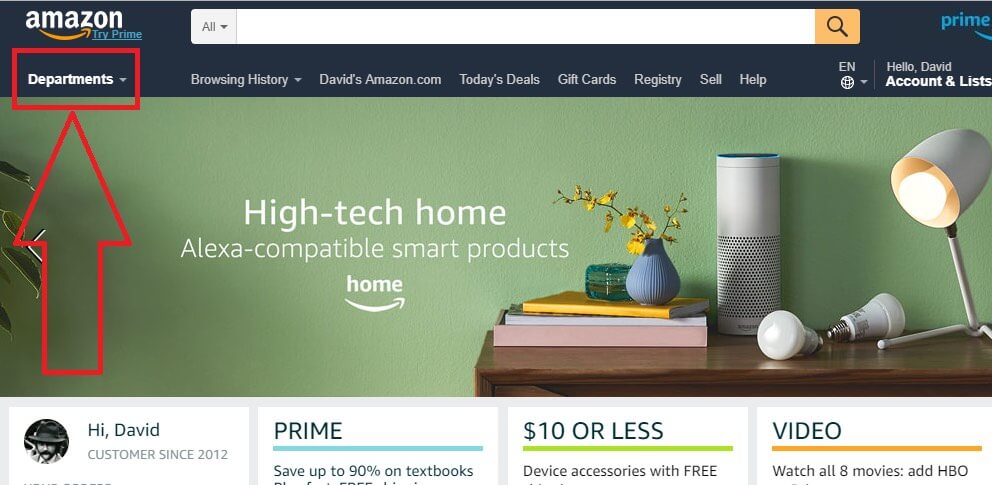
Step 2: Click on "Kindle Books" (note they show slightly different pop-up screens here at different times but just look for Kindle Books and click that)
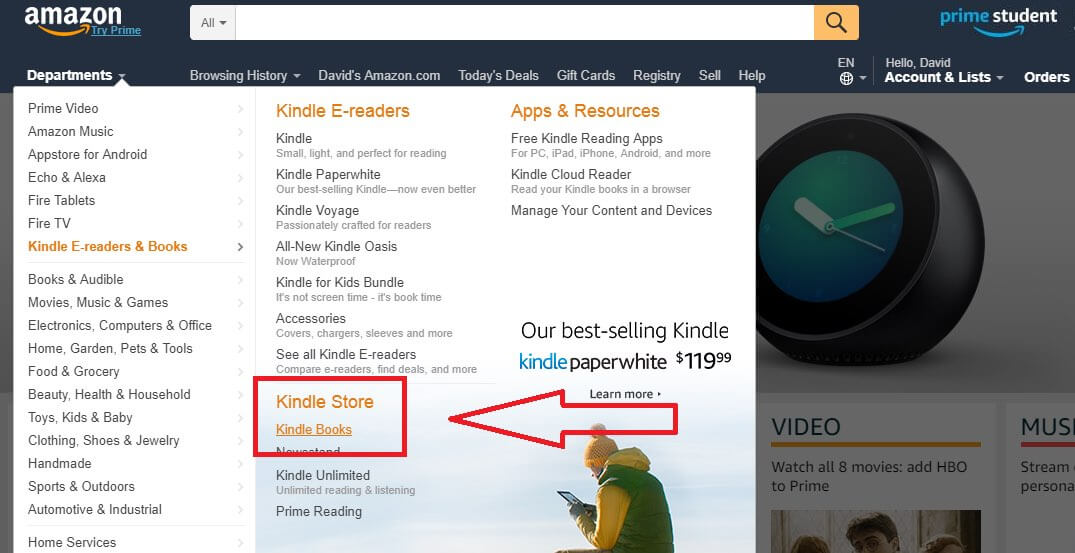
Step 3: You are now on the Popularity List.
Step 4: BUT you have to scroll past all this stuff to see the start of the list.
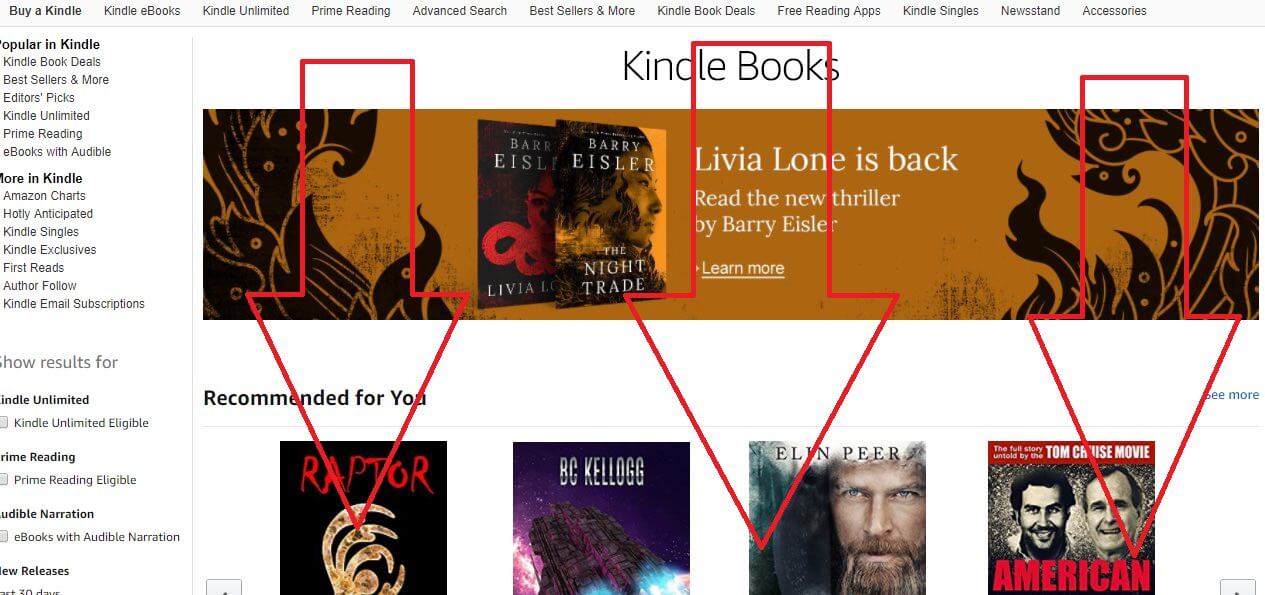
Step 5: When you FINALLY get down to a set of results that looks kind of like search results, this is the start of the Popularity List. The red arrows are pointing to the #1 book.
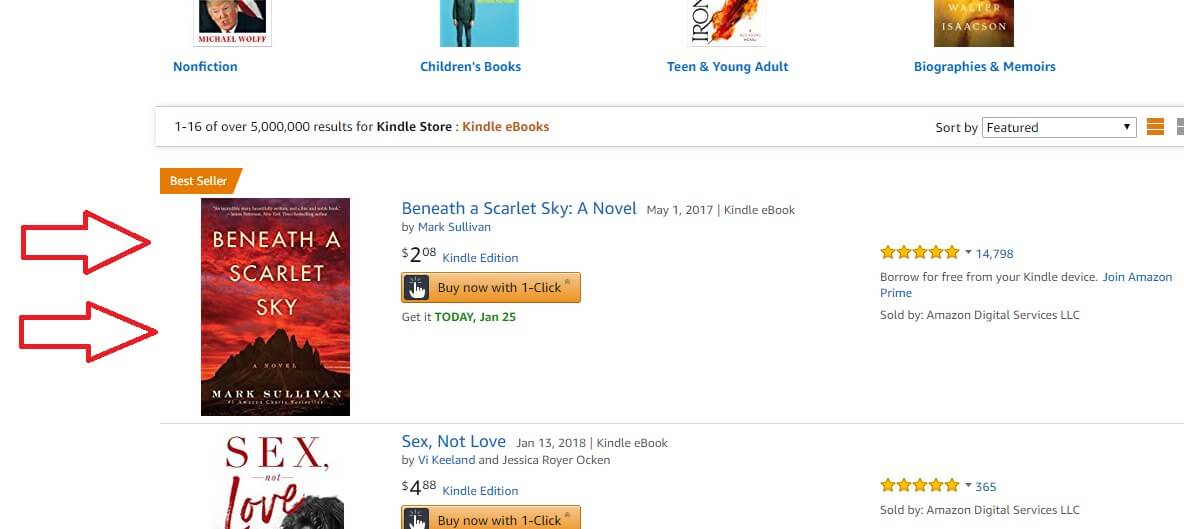
Step 6: To wrap this up, just want to point out the Popularity List is broken down into all the same categories and sub-categories as the Best Seller lists, and if you click on the sidebar on the left you can drill down to where you want to go!
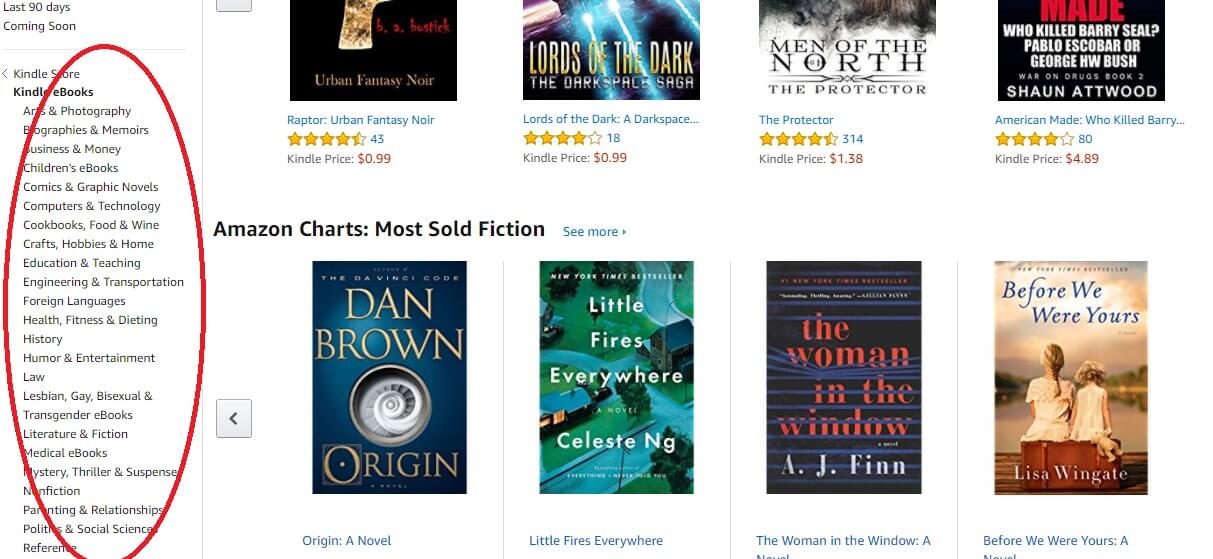
Now what you'll notice is it looks a little bit like the bestseller list. It's broken down into the same categories and subcategories. On the left-hand side of the screen, you'll see that it's broken down into romance, science fiction, all the usual categories and subcategories of books. The exact same font as the bestseller list.
But what you'll notice is that the order of books is different. There are some books there that aren't even on the bestseller list. And there are some that are on the bestseller list that aren't even there. I'll explain why the order of books is different in a moment and why it's important.
Why is this important?
It's kind of strange to be talking about something that's so varied because you're probably thinking, “why is this important if it's so hard to find?” To get into the “time travel romance” popularity list you have to make 12 clicks. No reader's going to do that, you're probably thinking. And you're right. No reader does.
The reason why the popularity list is important is that it's a huge driver of recommendations to Amazon customers.
For example, if you're a KU subscriber, Kindle Unlimited subscriber the popularity list is one of the main influencers on which books get recommended to Kindle Unlimited subscribers. If your book is riding high on the popularity list you're going to see a huge increase in page reads. I'll get into more detail in a moment.
The other reason why it's important is not everyone browses the Amazon website from a desktop. Many people do it from their device. Particularly Kindle Fire because that's much easier to browse the store than the old Kindles or even the phone. When Kindle Fire customers think they're going to the bestseller list, they don't actually get pushed to the bestseller list. They get pushed to the popularity list.
The reason why that is important is because the popularity list is completely made up of different stuff.
The difference between the popularity list and the bestseller list
I'll just break it down slightly. Okay, the key differences between the popularity list and the bestseller list are fundamental. For starters, the bestseller list as you know is broken up into two separate lists. One for freebies and one for sales.
There are no freebies on the actual paid bestseller list. But if you look at the popularity list you'll notice there are free books in there. Free books and pay books are mixed together. Freebies actually count.
If you had been a self publisher for a while, you might remember the original KDP Select: where you would just make a book free for a few days and it would get twenty, thirty thousand downloads without even advertising that hard... and then afterwards it would sell thousands of copies without you even doing anything: it would just bounce.
The book would bounce up the bestseller list afterward and nobody really knew why. Well, the reason was the popularity list. Because all of those free downloads were getting counted as sales on the popularity list, which meant once you came back to paid, your book would jump right up the popularity list and all these customers would start getting recommended it and they'd start buying.
Another key difference between the popularity list and the bestseller list is that borrows are not counted on the popularity list. This is going to blow some people's minds I think because everyone is always thinking that Amazon is putting their finger on the scale and trying to force people into Kindle Unlimited by favoring Kindle Unlimited books. It does in some ways but on the bestseller list, if someone borrows your book that counts as a sale. It doesn't on the popularity list at all.
I think the reason why they do that is that it would just be too powerful and they want to break the chain slightly and they're out to create this feedback loop where the entire charts would get completely dominated by Kindle Unlimited books. They want that to a certain extent obviously: they want Kindle Unlimited to be a success but they don't want to completely shut out all the other books.
They don't actually want to do that. They know there are still readers out there for Nora Roberts and Stephen King and all those other people. And Amazon actually is always trying to balance things out. They'll make borrows count on the bestseller list but then they won't count them on the popularity list. They won't count freebies on the bestseller list but they will on the popularity list.
The popularity list is the list they always use to balance things out. They're always very slow to make changes to the bestseller list 'cause people will notice that straight away and freak out that Amazon is manipulating the store or something. But with the popularity list, they play with that quite a lot and when you hear people talk about big algorithm changes it's usually they've done something to the popularity list. If you feel like something has changed, that's the first spot to look.
The bestseller list is just a reflection of your sales. There are only two ingredients in the bestseller list. That's 1. sales and borrows (which are counted as sales), and 2. time, as sales will decay.
The popularity list is calculated completely differently. It's a rolling turning day average of all your sales. No borrows but freebies are counted. Not counted as a full sale but as about 100th of a sale.
It used to be about two, three years ago they were counted as 1/10th of a sale. If you've been around that long in self-publishing, you might remember a few years ago people were talking about a big algorithm change that really screwed over free books — this is what it was. They reduced the weighting for freebies.
All books are weighted. Amazon actually has price weighting on the popularity list. That's another huge difference. And what that means is if your book is priced $9.99 that sale will be worth way more than a book priced at 99 cents. You will see on the popularity list that higher priced books will dominate more than on the bestseller list.
And again, this is something that kind of favors traditionally published books more than self-published books. You know, I don't want you to see this as something that Amazon uses to beat down self-publishers. Again, it's about that balance. Amazon is always looking for that balance. I think when they launched KDP Select, they found too many books unworthy of chart position were getting up to the top of the charts so Amazon tried to dampen that down a little bit by not counting freebies as full sales on the popularity list. And they're always playing with that mix.
Sometimes I've seen suggestions that it might favor Amazon-published books but I've seen them make changes to the algorithm and changes to the popularity list which actually disfavored Amazon published books so I wouldn't always assume that Amazon is doing something for their own selfish interests. They're taking a longer-term view a lot of the time. I think they do a lot of split testing so they see what's working for readers basically.
Two more interesting things about the popularity list that will change how you approach your market.
Launch day suppression
One is that it seems to suppress new releases a little bit. This is hard to figure out, so I wish I could be more exact for you. But this particularly relates to pre-orders. I usually stay away from pre-orders, because I think they actually sap a lot of strength from your launch — but I had a very particular circumstance this time where a pre-order was definitely going to be beneficial. So I'm experimenting with them for the first time. I'm watching my book on the popularity list and it's nowhere near where it should be. It's about 10 pages back from where it should be.
I started looking at a couple of other pre-orders that were selling well. One's from Bella Andre and the other one's from somebody else and again, they were five, six, seven pages back from where they should be. And then I started to look into the category. Any subcategory of the popularity list — and they were all way back from where they should be so I think Amazon might actually be attaching a kind of weighting to pre-orders, which kind of makes sense if you look at it from Amazon's perspective.
I guess not all readers like pre-orders. I'm one of them so I can't really judge here. I don't like pre-ordering stuff. I like having something now or not having it at all. I think there is quite a segment of readers that don't want their charts dominated by pre-orders. I can understand that. They basically put a weighting on them so they struggle on the popularity list.
But what I also think is after that book actually releases, those sales kick in on the popularity list which gives you a launch day boost, which is cool because a lot of people have been complaining that you don't get the same launch day boost as you do when you do a pre-order on Apple or elsewhere, because they roll up all the sales for launch day to give you a little algorithm boost.
Amazon does kind of do that in a backward way, I think. Hard to be definite about that one. I might know more about that in a week or two and I might blog about it.
The four-day lag
The one last thing before we get into direct marketing applications: there's a four day lag on the popularity list. What I mean by that is if I make a sale today to any of you lovely people, that actually won't count on the popularity list for another four days. This is hugely important, especially for people in Kindle Unlimited. Now if you've been on Kindle Unlimited you might have noticed that if you put together a quick promotion that you might have done okay out of it but page reads don't kick in right away. They do a little bit but the real spike in page reads comes a week later and it's kind of hard to figure out why that is.
Well, the reason is that the popularity list is such a huge driver of recommendations to KU subscribers... but there's a four-day lag before the sales kick in on it. You might be ranking high in the charts after your four or five-day promo but it'll take another four days before you actually jump up fully on the popularity list. It will take four days at least before your book starts getting recommended in such huge numbers to KU subscribers.
What you'll often see if you might put together a promotion. You might sell a few hundred books or whatever over a weekend and then it could be the next Wednesday, Thursday, Friday before the page reads start to kick in and you see then the graph start to go up and up and up and you're like, "Oh, where's this coming from?" Well, it's coming from the popularity list.
Running Kindle Unlimited Promos
And to give you a practical marketing application in relation to that, an actual takeaway you can apply this means if you're in Kindle Unlimited and you're doing a countdown deal or your five free days, that you should just hold off on increasing your prices too much. Often what I do after a five-day free run is I might stick the book to 99 cents straightaway. Even though you're thinking like, "I want to put it back up to $4.99. I want to make some money now."
In Kindle Unlimited I think you should be more aggressive about pricing and keep your prices down for longer after the promotion because as I said, it takes four days for those sales to kick in on the popularity list and I think it's better not to have your rank slip because as soon as you raise your prices after a promotion, your rank starts to slip. You're more expensive. There's more friction there. Therefore readers won't purchase if it's not as much of an impulse buy. It's natural.
If you can wait until the page reads kick in and then raise your price, you will see a much bigger page read wave and if you do it right, you can see a page read wave that can last for the rest of the month, sometimes longer. It's really something to behold when you've got it right.
Free is gold again!
I noticed this last year when I had a stand-alone book and I didn't know what to do. I was applying for a book club every so often. It's hard to get one when you're in KU and sometimes I’ll just stick in an application. I didn't really plan for it, because I'm so sure they're going to say no. They actually said yes and I was like, "Oh, sure. Now I've got to do something with this."
So, I put together a little promotion and I just used a “dry send” to my mailing list because it was book one of a series but book two wasn't out yet. It wasn't the best planning in the world but I just decided to roll with it. The book would run obviously a free book on BookBub always does well. Got like 30,000 downloads or something and then after I went back to paid I noticed maybe four, five days later, page reads to kick in and they just started going crazy the rest of the month which is great because I just put that book in KU and I didn't really have a plan for getting the reads going but that was a very easy one: put a book free for five days and just make sure you can rustle up 5,000 downloads because if you don't get at least 5,000 downloads you won't jump enough on the popularity list to trigger those recommendations to KU subscribers — which is what it's all about.
I think that's it. You can usually see me around on Facebook and Twitter and stuff and feel free to ask me any questions.
Sign up to David’s mailing list to get a free copy of his book, Following: A Marketing Guide to Author Platform. If you have any questions for him, feel free to drop them in the comments below.



